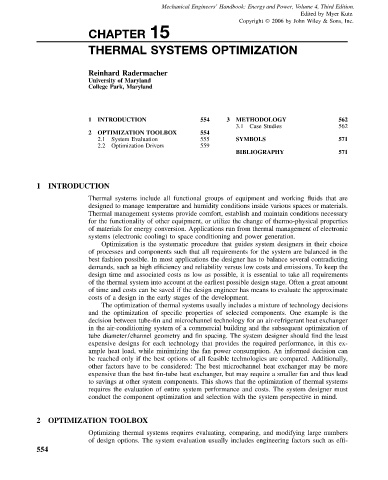Page 565 - Mechanical Engineers' Handbook (Volume 4)
P. 565
Mechanical Engineers’ Handbook: Energy and Power, Volume 4, Third Edition.
Edited by Myer Kutz
Copyright 2006 by John Wiley & Sons, Inc.
CHAPTER 15
THERMAL SYSTEMS OPTIMIZATION
Reinhard Radermacher
University of Maryland
College Park, Maryland
1 INTRODUCTION 554 3 METHODOLOGY 562
3.1 Case Studies 562
2 OPTIMIZATION TOOLBOX 554
2.1 System Evaluation 555 SYMBOLS 571
2.2 Optimization Drivers 559
BIBLIOGRAPHY 571
1 INTRODUCTION
Thermal systems include all functional groups of equipment and working fluids that are
designed to manage temperature and humidity conditions inside various spaces or materials.
Thermal management systems provide comfort, establish and maintain conditions necessary
for the functionality of other equipment, or utilize the change of thermo-physical properties
of materials for energy conversion. Applications run from thermal management of electronic
systems (electronic cooling) to space conditioning and power generation.
Optimization is the systematic procedure that guides system designers in their choice
of processes and components such that all requirements for the system are balanced in the
best fashion possible. In most applications the designer has to balance several contradicting
demands, such as high efficiency and reliability versus low costs and emissions. To keep the
design time and associated costs as low as possible, it is essential to take all requirements
of the thermal system into account at the earliest possible design stage. Often a great amount
of time and costs can be saved if the design engineer has means to evaluate the approximate
costs of a design in the early stages of the development.
The optimization of thermal systems usually includes a mixture of technology decisions
and the optimization of specific properties of selected components. One example is the
decision between tube-fin and microchannel technology for an air-refrigerant heat exchanger
in the air-conditioning system of a commercial building and the subsequent optimization of
tube diameter/channel geometry and fin spacing. The system designer should find the least
expensive designs for each technology that provides the required performance, in this ex-
ample heat load, while minimizing the fan power consumption. An informed decision can
be reached only if the best options of all feasible technologies are compared. Additionally,
other factors have to be considered: The best microchannel heat exchanger may be more
expensive than the best fin-tube heat exchanger, but may require a smaller fan and thus lead
to savings at other system components. This shows that the optimization of thermal systems
requires the evaluation of entire system performance and costs. The system designer must
conduct the component optimization and selection with the system perspective in mind.
2 OPTIMIZATION TOOLBOX
Optimizing thermal systems requires evaluating, comparing, and modifying large numbers
of design options. The system evaluation usually includes engineering factors such as effi-
554

